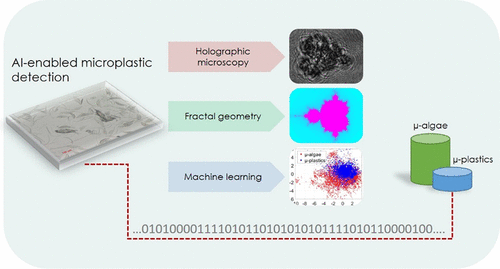当前位置:
X-MOL 学术
›
ACS Photonics
›
论文详情
Our official English website, www.x-mol.net, welcomes your feedback! (Note: you will need to create a separate account there.)
Identification of Microplastics Based on the Fractal Properties of Their Holographic Fingerprint
ACS Photonics ( IF 7 ) Pub Date : 2021-06-18 , DOI: 10.1021/acsphotonics.1c00591 Vittorio Bianco 1 , Daniele Pirone 1, 2 , Pasquale Memmolo 1 , Francesco Merola 1 , Pietro Ferraro 1
ACS Photonics ( IF 7 ) Pub Date : 2021-06-18 , DOI: 10.1021/acsphotonics.1c00591 Vittorio Bianco 1 , Daniele Pirone 1, 2 , Pasquale Memmolo 1 , Francesco Merola 1 , Pietro Ferraro 1
Affiliation

|
Water plastic pollution is a serious problem affecting sealife, marine habitats, and the food chain. Artificial intelligence-enabled coherent imaging has recently shown exciting advances in the field of environmental monitoring, and portable holographic microscopes are good candidates to map the microparticles content of marine waters. The “holographic fingerprint” due to coherent light diffraction is rich in information, fully encoded into the complex wavefront scattered by the sample. Hence, proper analysis of the wavefronts reconstructed from digital holograms can unlock new possibilities in the fields of diagnostics and environmental monitoring. Fractal geometry well describes natural objects and allows inferring added-value information on the way these fill 2D spaces and 3D volumes. The most abundant micron-scale class of objects that populate marine waters consists of microalgae named diatoms, which are of interest as bioindicators of water quality. Here we investigate the fractal properties of holographic patterns of diatoms and microplastics, considering a heterogeneous mixture of five types of plastic materials and 55 different species of microalgae. We show that, different from the case of weak scattering objects, a small set of fractal parameters is able to characterize these two large ensembles. As an applicative example, we carry out classification tests to show the possibility to identify the two classes with high accuracy. This new holographic fractal description of scattering micro-objects could be used in the near future for in situ automatic mapping of microplastic pollutants and for taxonomy of diatoms as water quality bioindicators, screened onboard holographic systems.
中文翻译:

基于全息指纹分形特性的微塑料识别
水塑料污染是影响海洋生物、海洋栖息地和食物链的严重问题。人工智能支持的相干成像最近在环境监测领域取得了令人振奋的进展,便携式全息显微镜是绘制海水微粒含量图的理想选择。由于相干光衍射产生的“全息指纹”信息丰富,完全编码为样品散射的复杂波前。因此,对从数字全息图重建的波前进行正确分析可以在诊断和环境监测领域开启新的可能性。分形几何很好地描述了自然物体,并允许推断关于这些物体填充 2D 空间和 3D 体积的方式的附加值信息。海洋水域中最丰富的微米级物体由名为硅藻的微藻组成,它们作为水质的生物指标很受关注。在这里,我们考虑了五种塑料材料和 55 种不同种类的微藻的异质混合物,研究了硅藻和微塑料的全息图案的分形特性。我们表明,与弱散射物体的情况不同,一小组分形参数能够表征这两个大型集合。作为一个应用示例,我们进行分类测试以展示以高精度识别这两个类别的可能性。
更新日期:2021-07-21
中文翻译:

基于全息指纹分形特性的微塑料识别
水塑料污染是影响海洋生物、海洋栖息地和食物链的严重问题。人工智能支持的相干成像最近在环境监测领域取得了令人振奋的进展,便携式全息显微镜是绘制海水微粒含量图的理想选择。由于相干光衍射产生的“全息指纹”信息丰富,完全编码为样品散射的复杂波前。因此,对从数字全息图重建的波前进行正确分析可以在诊断和环境监测领域开启新的可能性。分形几何很好地描述了自然物体,并允许推断关于这些物体填充 2D 空间和 3D 体积的方式的附加值信息。海洋水域中最丰富的微米级物体由名为硅藻的微藻组成,它们作为水质的生物指标很受关注。在这里,我们考虑了五种塑料材料和 55 种不同种类的微藻的异质混合物,研究了硅藻和微塑料的全息图案的分形特性。我们表明,与弱散射物体的情况不同,一小组分形参数能够表征这两个大型集合。作为一个应用示例,我们进行分类测试以展示以高精度识别这两个类别的可能性。


























 京公网安备 11010802027423号
京公网安备 11010802027423号